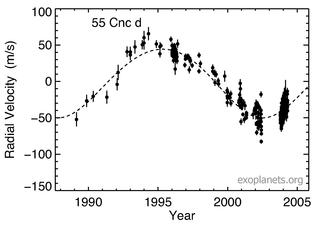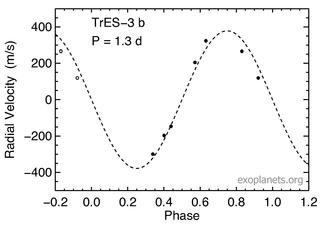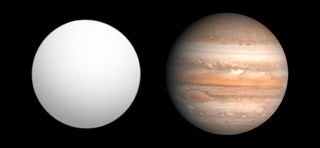
HD 209458 b is an exoplanet that orbits the solar analog HD 209458 in the constellation Pegasus, some 157 light-years from the Solar System. The radius of the planet's orbit is 0.047 AU, or one-eighth the radius of Mercury's orbit. This small radius results in a year that is 3.5 Earth-days long and an estimated surface temperature of about 1,000 °C. Its mass is 220 times that of Earth and its volume is some 2.5 times greater than that of Jupiter. The high mass and volume of HD 209458 b indicate that it is a gas giant.
HD 130322 is a star with a close orbiting exoplanet in the constellation of Virgo. The distance to this system is 104 light years, as determined using parallax measurements. It is drifting closer to the Sun with a radial velocity of −12.4 km/s. With an apparent visual magnitude of 8.04, it is too dim to be visible to the naked eye; requiring binoculars or a small telescope to view. Being almost exactly on the celestial equator the star is visible everywhere in the world except for the North Pole. The star shows a high proper motion, traversing the celestial sphere at an angular rate of 0.197 arcsec yr−1.

HD 149026 b, formally named Smertrios, is an extrasolar planet and hot Jupiter approximately 250 light-years from the Sun in the constellation of Hercules.

55 Cancri b, occasionally designated 55 Cancri Ab, also named Galileo, is an exoplanet orbiting the Sun-like star 55 Cancri A every 14.65 days. It is the second planet in order of distance from its star, and is an example of a hot Jupiter, or possibly rather "warm Jupiter".

55 Cancri d, formally named Lipperhey, is an extrasolar planet in a long-period orbit around the Sun-like star 55 Cancri A. Located at a similar distance from its star as Jupiter is from the Sun, it is the fifth and outermost known planet in its planetary system. 55 Cancri d was discovered on June 13, 2002.

XO-1 is a magnitude 11 G-type main-sequence star located approximately 530 light-years away in the constellation Corona Borealis. XO-1 has a mass and radius similar to the Sun. In 2006 the extrasolar planet XO-1b was discovered orbiting XO-1 by the transit method using the XO Telescope.

XO-1b is an extrasolar planet approximately 536 light-years away from Earth.

Upsilon Andromedae b, formally named Saffar, is an extrasolar planet approximately 44 light-years away from the Sun in the constellation of Andromeda. The planet orbits its host star, the F-type main-sequence star Upsilon Andromedae A, approximately every five days. Discovered in June 1996 by Geoffrey Marcy and R. Paul Butler, it was one of the first hot Jupiters to be discovered. It is also one of the first non-resolved planets to be detected directly. Upsilon Andromedae b is the innermost-known planet in its planetary system.

HAT-P-1b is an extrasolar planet orbiting the Sun-like star HAT-P-1, also known as ADS 16402 B. HAT-P-1 is the dimmer component of the ADS 16402 binary star system. It is located roughly 521 light years away from Earth in the constellation Lacerta. HAT-P-1b is among the least dense of any of the known extrasolar planets.

Any planet is an extremely faint light source compared to its parent star. For example, a star like the Sun is about a billion times as bright as the reflected light from any of the planets orbiting it. In addition to the intrinsic difficulty of detecting such a faint light source, the light from the parent star causes a glare that washes it out. For those reasons, very few of the exoplanets reported as of January 2024 have been observed directly, with even fewer being resolved from their host star.

TrES-3b is an extrasolar planet orbiting the star GSC 03089-00929. It has an orbital period of just 31 hours and nearly twice the mass of Jupiter.

XO-3b is an exoplanet with about 11.79 times the mass of Jupiter, and it orbits its parent star in about 3.2 days. The radius of this object is 1.217 times that of Jupiter. Astronomers announced their discovery on May 30, 2007, at the American Astronomical Society in Honolulu, Hawaii. Its discovery is attributed to the combined effort of amateur and professional astronomers working together on the XO Project using a telescope located on the Haleakala summit in Hawaii.
The XO Project is an international team of amateur and professional astronomers tasked with identifying extrasolar planets. They are led by Peter R. McCullough of the Space Telescope Science Institute. It is primarily funded by NASA's Origins Program and the Director's Discretionary Fund of the Space Telescope Science Institute.

Epsilon Eridani b, also known as AEgir [sic], is an exoplanet approximately 10.5 light-years away orbiting the star Epsilon Eridani, in the constellation of Eridanus. The planet was discovered in 2000, and as of 2023 remains the only confirmed planet in its planetary system. It orbits at around 3.5 AU with a period of around 7.6 years, and has a mass around 0.6 times that of Jupiter. As of 2023, both the Extrasolar Planets Encyclopaedia and the NASA Exoplanet Archive list the planet as 'confirmed'.

HAT-P-3b, also named Teberda, is an extrasolar planet that orbits the star HAT-P-3 approximately 450 light-years away in the constellation of Ursa Major. It was discovered by the HATNet Project via the transit method and confirmed with Doppler spectroscopy, so both its mass and radius are known quite precisely. Based on these figures it is predicted that the planet has about 75 Earth masses' worth of heavy elements in its core, making it similar to the planet HD 149026 b.
XO-5 is a yellow dwarf main sequence star located approximately 893 light-years away from Earth in the Lynx constellation. It has a magnitude of about 12 and cannot be seen with the naked eye but is visible through a small telescope.

XO-4b is an extrasolar planet approximately 956 light years away in the constellation of Lynx. This planet was found by the transit method by McCullough in May 2008. The planet has mass 1.72 MJ and radius 1.34 RJ. This planet orbits very close to the F-type parent star, as it is typical for transiting planets, classing this planet as Hot Jupiter.
XO-4 is a star located approximately 863 light-years away from Earth in the Lynx constellation. It has a magnitude of about 11 and cannot be seen with the naked eye but is visible through a small telescope. A search for a binary companion star using adaptive optics at MMT Observatory was negative.

Kepler-7b is one of the first five exoplanets to be confirmed by NASA's Kepler spacecraft, and was confirmed in the first 33.5 days of Kepler's science operations. It orbits a star slightly hotter and significantly larger than the Sun that is expected to soon reach the end of the main sequence. Kepler-7b is a hot Jupiter that is about half the mass of Jupiter, but is nearly 1.5 times its size; at the time of its discovery, Kepler-7b was the second most diffuse planet known, surpassed only by WASP-17b. It orbits its host star every five days at a distance of approximately 0,06 AU. Kepler-7b was announced at a meeting of the American Astronomical Society on January 4, 2010. It is the first extrasolar planet to have a crude map of cloud coverage.
WASP-24 is an F-type star with the Hot Jupiter planet WASP-24b in orbit. WASP-24 is slightly larger and more massive than the Sun, it is also has a similar Metallicity and is hotter than the Sun. WASP-24 was first observed by the SuperWASP planet-searching organization, which flagged it as a potential host to a planet before following up with radial velocity and spectral measurements. Analysis of these confirmed the planetary nature of WASP-24b, which was later released to the public on the SuperWASP website.















